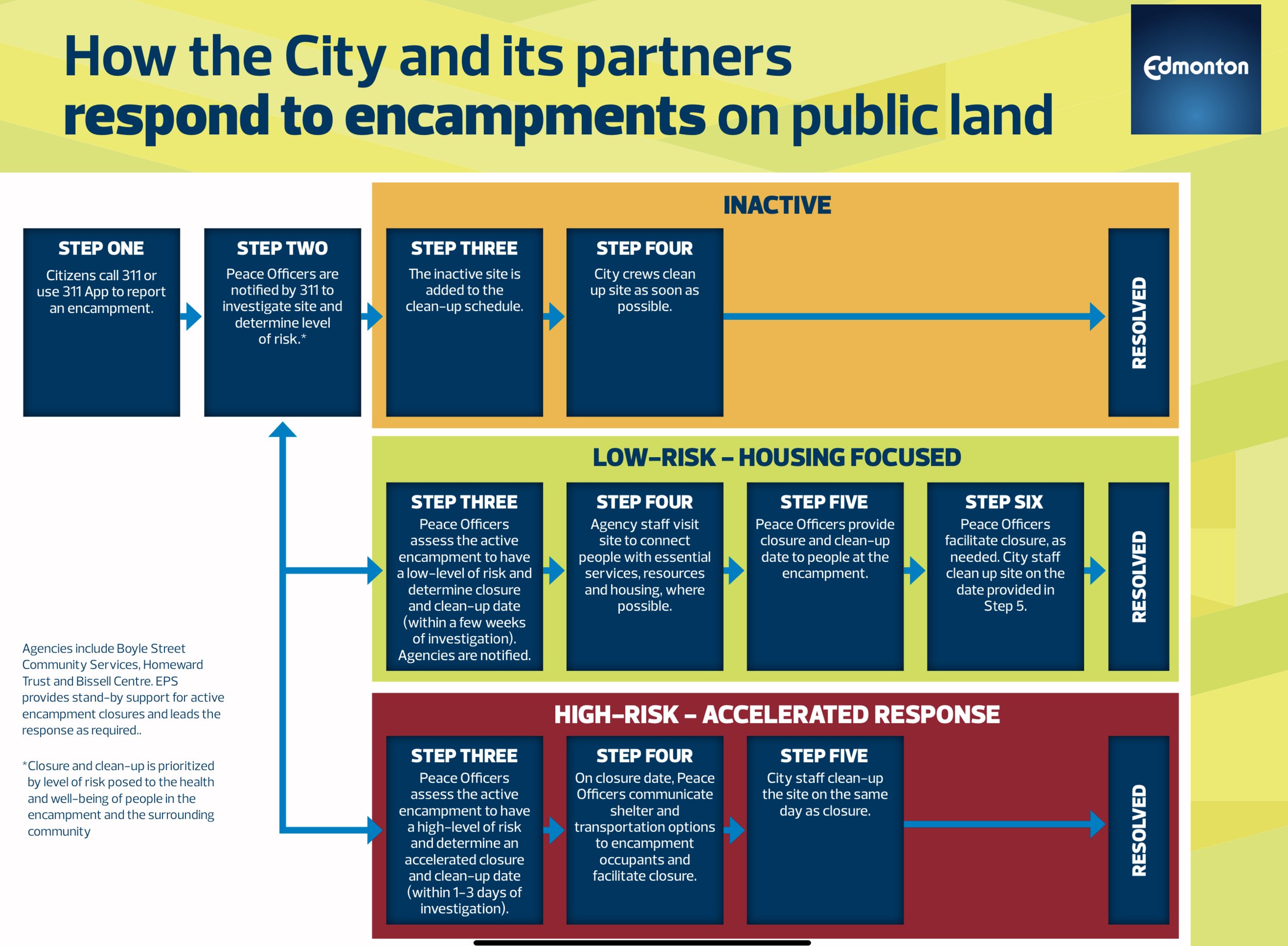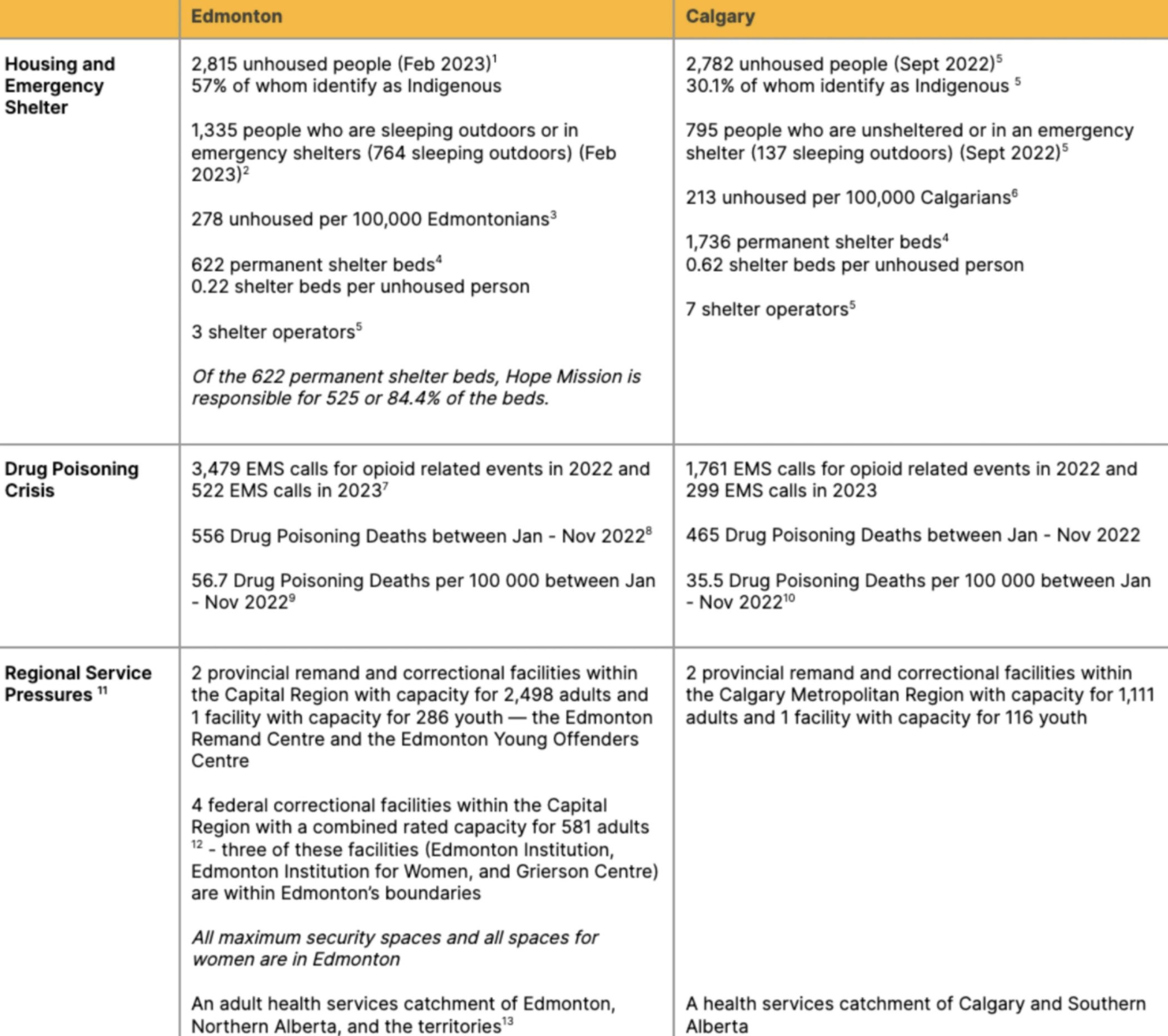Encampment Response in Edmonton (May 2023)
I know I’ve written about housing and encampments many times but based on the number of calls and emails I have been receiving in the last two weeks, I wanted to write a longer post that covers the process our Park Rangers take when an encampment is reported, how this issue can properly be addressed, and what the City is doing to try and fill in the gaps while we await the full solution from the provincial government.
I need to start with an important point I have said many times:
Housing, shelter operations, and mental health/addictions support are all provincial jurisdiction.
To be clear, I don’t say that to pass the buck to the province because as you will see later in this post, the City has invested heavily in trying to help address this in the interim. I always try to stress the point above as it is important for everyone to know who is ultimately responsible for addressing a very serious issue. Since we are also in a provincial election, this gives each of you the opportunity to ask any candidate who comes to your door how they will help with this.
When someone reports an encampment to 311 the Park Rangers will take the following approach:
As you can see from the response plan above, depending on the level of risk in the encampment, closure can take anywhere from 1 day to a few weeks.
With the number of people experiencing homelessness having doubled in the last 4 years combined with the shortage of day shelter and shelter beds, I expect this year will see the most number of encampments ever. This will also mean that it will take longer to address each encampment because while there are more people doing that work in the city, it’s not enough to keep up with the growth. In fact, we are already seeing encampments start up soon after an encampment in the same spot was closed down. To address this in a meaningful way, more permanent solutions are needed.
Here is an important chart that Mayor Sohi put together for Premier Smith for a meeting back in March:
There are a few important numbers that jump out at me. The first is that while Calgary has a larger population than Edmonton, the number of unhoused people is about the same with Edmonton at 2,815 and Calgary at 2,782. Even though we have slightly more people experiencing homelessness, we have more than 1,100 fewer permanent shelter beds in Edmonton. Due to this variance, it shouldn’t be surprising that we have far more people sleeping outdoors than in Calgary and that number only increases as the weather warms up.
To help reduce the number of encampments, one of the most immediate measures that the provincial government can take is to provide Edmonton with the same number of shelter beds as there are in Calgary. Along with shelter beds, another important change that must be made by the provincial government is to adopt the minimum emergency shelter standards. Since most shelters across Alberta don’t operate 24/7, unhoused people will often leave the overnight shelters early in the morning and will seek refuge in transit centres, parks (especially in the spring, summer, and fall), beside businesses across the city, and many other locations.
The Government of Alberta’s own Coordinated Community Response to Homelessness Task Force released a report late last year which recommended that they implement the minimum emergency shelter standards. To date, they have not been implemented nor has the funding been provided to the shelter operators across the province to put those recommendations into action. We will continue to engage the provincial government and offer to help them fulfill their own recommendations which would be a huge step forward.
The provincial government has done an excellent job over the last few years with increasing the number of addictions treatment beds. They have surpassed their original target from a few years ago and I thank them for investing in addictions treatment spaces.
Like with shelter spaces, addiction treatment beds are just one tool in the toolkit and we cannot exclusively rely on those to solve our problems. If we could, we wouldn’t still be dealing with the issues that we are facing across all of Alberta. I will continue to support their further investment in this space but since we are dealing with a record number of drug poisoning deaths, we also need to address the gap in short-term harm reduction spaces to ensure that those who are struggling are able to stay alive in order to then access the more permanent solutions.
There is still a significant gap for 24/7 supportive housing. Although former Premier Kenney did announce funding for the operations of the 24/7 supportive housing units that the City of Edmonton built in partnership with the federal government and housing providers, the units built over the last 4 years is not enough as seen in the chart above.
Although housing is not municipal jurisdiction, we did approve a significant amount of funding for housing in the 2023-2026 budget (over $120 million). That funding is similar to the funding approved in the 2019-2022 budget (over $130 million). Even with the federal funding recently announced, the funding from 2023-2026 won’t result in enough units built to help everyone and those new units will likely take around 2 years to build. Considering the size of the provincial surplus and that housing is their jurisdiction, we hope to partner with them to ensure the construction of all the necessary units of 24/7 supportive housing and the operations of those units. As we have seen, 24/7 supportive housing saves lives and it saves the provincial government money. You can learn more about that from this post I wrote.
Another area we are looking to fill in on is for the current day shelter spaces in operations. Unfortunately, on Monday we learned that Boyle Street is aware that at least 51 people experiencing homelessness have lost their lives in the first 3 months of 2023.
51 People
This is a tragic loss of life that should never be allowed to continue.
Funding for both Boyle Street and Bissell Centre is running out and without about $4.1 million, many of their daytime services will stop or be significantly reduced. A motion will be coming to council on May 16th to provide that funding. While this isn’t our jurisdiction, I will be supporting this motion because if we don’t approve this funding, there will be even more loss of life and there will be even more encampments than we have now.
Another good example of interim solutions is the site at the old Bedford Inn. In the last 101 days, Jasper Place Wellness Centre has helped 28 people get permanent housing. The bridge housing portion of this space is completely full and there is far more demand than room available. For the emergency shelter spaces, which do not have private rooms, they find that on average, 80 people are staying overnight with more people using the shelter services during the day.
Jasper Place Wellness Centre regularly engages with everyone who accesses their services. Those that visit are coming from across West Edmonton. They are seeing people come as far west as the Henday and as far east as Westmount. The individuals they are serving have always been in the west end but they are a bit more visible now that there is a place to get service in the west end of the city. Contrary to some comments I have seen, there aren’t individuals coming from downtown to the west end, the issue is that the total number of people experiencing homelessness has doubled since 2019.
We are at a crisis point. The City of Edmonton will continue to do everything possible to help but we need the order of government who has the financial resources and the jurisdiction to fulfill their obligations. We are willing partners as we have proven through our collaboration with the federal government, housing providers, and other social agencies. If all orders of government are working together with the social agencies and housing providers, this crisis can be solved quickly. While this challenge isn’t unique to Edmonton, we have a clear path to fixing it.
I’ll close with the same point I wrote in a previous blog from March. Housing saves lives. Housing saves money. The evidence is clear. As we come up to the provincial election, please make sure you are asking candidates about how they will not only address housing issues, but also shelter operations, addictions support, and mental health support.


